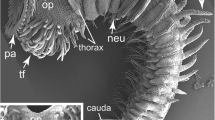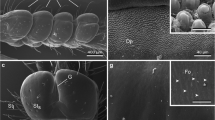Summary
-
1.
The cuticle of respiratory organs has been investigated in 19 species of different groups of arthropods with respect to the texture of microfibrils in it. Microfibrils, probably containing the chitin, always are present and consist of units, which appear to be globular after shadow casting with platinum; these globules have a diameter of about 100–200 Å. The microfibrils tend to bundle and form either the irregular, feltlike dispersed texture, or the parallel texture, consisting of layers of microfibrils in parallel arrangement. Between these two, there are all types of transition. There are numerous pore canals, penetrating the cuticle, except for the epicuticle.
-
2.
In Limulns polyphemus the cuticle of the gills shows pore fields of different extension, which do not penetrate the epicuticle. “Trabekel” are absent.
-
3.
The cuticle of the lung-books in terrestrial Chelicerata have no pore fields. In scorpions it is covered with little pillars or pegs (“Trabekel”) on either side of the sacs of the lung-books, in the rest of the Arachnida — as far as they possess lung-books — on one side of the sacs only. A “Trabekel” consists of a bundle of microfibrils being embedded in ground substance. At the base of the “Trabekel” this bundle ramifies to anchor the “Trabekel” in the surrounding cuticle.
-
4.
In scorpions the “Trabekel” show a tendency to fuse and thus form ledges; this tendency appears to a different degree in the particular families. It has not been observed in a whipscorpion (Pedipalpi) and spiders (Araneae).
-
5.
The gills of Crustacea and the gill-like appendages of the larvae and pupae of some aquatic insects have the same texture of microfibrils as the surrounding cuticle.
-
6.
The gills of the larvae of Agrion sp. and Lestes viridis (Odonata, Zygoptera) possess a cuticle with pore fields of different extension, which do not penetrate the epicuticle. Their pores have a diameter of about 1500 Å. These pore fields may facilitate the penetration of secretions from numerous secretory cells of the epidermis.
Zusammenfassung
-
1.
Bei 19 Arten aus verschiedenen Arthropodengruppen wurde die Kutikula von Atemorganen bezüglich ihrer Mikrofibrillentexturen untersucht. Die stets vorhandenen, wahrscheinlich das Chitin enthaltenden Mikrofibrillen bestehen aus Einheiten, die nach der Bedampfung mit Platin kugelförmig erscheinen und einen Durchmesser von etwa 100–200 Å aufweisen. Diese Mikrofibrillen neigen zur Bildung von Bündeln und vereinigen sich zur unregelmäßigen, filzartigen sog. Streuungstextur, oder zu Schichten aus parallel angeordneten Mikrofibrillen, der sog. Paralleltextur. Zwischen beiden gibt es alle möglichen Übergänge. Allenthalben trifft man in der Kutikula Porenkanäle an.
-
2.
Die Kutikula der Kiemen von Limulus polyphemus weist Porenfelder von verschiedenem Umfang auf, die jedoch nicht bis in die Epikutikula reichen. Trabekel sind nicht vorhanden.
-
3.
Die Kutikula der Fächerlungen landbewohnender Cheliceraten enthielt keine Porenfelder. Sie ist bei den Skorpionen auf beiden Seiten eines Fächerlungensäckchens mit säulenförmigen sog. Trabekeln besetzt, bei den übrigen Arachniden — so weit sie Fächerlungen besitzen — nur auf einer Seite. Die einzelnen Trabekel bestehen aus einem Bündel von Mikrofibrillen, das in Grundsubstanz eingebettet ist. An der Basis eines Trabekels zweigt dieses Bündel auf und verankert ihn in der umgebenden Kutikula.
-
4.
Bei den Skorpionen besteht innerhalb der einzelnen Familien in unterschiedlichem Maße die Tendenz, durch Verschmelzung von Trabekeln Leisten zu entwickeln. Beim Geißelskorpion (Pedipalpi) und bei Webespinnen (Araneae) trat diese Tendenz nicht auf.
-
5.
Die Kiemen der Krebse und die kiemenartigen Körperanhänge der Larven bzw. Puppen wasserbewohnender Insekten zeigten die gleiche Mikrofibrillentextur wie die benachbarten Kutikulapartien.
-
6.
Die Kiemen der Larven von Agrion sp. und Lestes viridis (Odonata, Zygoptera) weisen in der Kutikula, mit Ausnahme der Epikutikula, Porenfelder verschiedener Größe auf. Die einzelnen Poren haben einen Durchmesser von etwa 1500 Å. Diese Porenfelder könnten für die Erleichterung des Durchtritts von Sekreten aus den zahlreichen Drüsenzellen der Epidermis von Bedeutung sein.
Similar content being viewed by others
Literatur
Böhmer, H.: Untersuchungen über das Wachstum und den Feinbau der Zellwände in der Avena-Koleoptile. Planta (Berl.) 50, 461–497 (1958).
Franke, W.: Über die Beziehungen der Ektodesmen zur Stoffaufnahme durch Blätter. I. Mitt.: Beobachtungen an Plantago major L. Planta (Berl.) 55, 390–423 (1960).
—: Über die Beziehungen der Ektodesmen zur Stoffaufnahme durch Blätter. II. Mitt.: Beobachtungen an Helxine soleirolii Req. Planta (Berl.) 55, 533–541 (1960).
—: Über die Beziehungen der Ektodesmen zur Stoffaufnahme durch Blätter. III. Mitt.: Nachweis der Beteiligung der Ektodesmen an der Stoffaufnahme durch Blätter mittels radioaktiver Stoffe. Planta (Berl.) 61, 1–16 (1964).
—: Ektodesmenstudien. III. Mitt.: Zur Frage der Struktur der Ektodesmen. Planta (Berl.) 63, 279–300 (1964).
Gessner, F., u. Gertrud Volz: Die Kutikula der Hydropoten von Nymphaea. Planta (Berl.) 39, 171–174 (1951).
Kästner, A.: Bau und Funktion der Fächertracheen einiger Spinnen. Z. Morph. Ökol. Tiere 13, 463–558 (1929).
Koch, H.: Natuurvet. Tijdschr. 16, 75–80 (1934). Zit. nach Wigglesworth (1953) s. unten.
Lambertz, P.: Untersuchungen über das Vorkommen von Plasmodesmen in Epidermis außenwänden. Planta (Berl.) 44, 147–190 (1954).
Laurie, M.: Notes on the anatomy of some scorpions and its bearing on the classification of the order. Ann. Nat. Hist. 17, 185–194 (1896).
—: Further notes on the anatomy and development of scorpions, and their bearing on the classification of the order. Ann. Nat. Hist. 18, 121–133 (1896).
Lorenzen, H.: Über die Ektodesmen. Naturwiss. Rdsch. 13, 143 (1960).
Mueller, L. E., P. H. Carr, and W. E. Loomis: The submicroscopic structure of plant surfaces. Amer. J. Bot. 41, 593–600 (1954).
Pawlowsky, E.: Studies on the organisation and development of scorpions. 5. The lungs. Quart. J. micr. Sci. 70, 135–146 (1926).
Peters, W.: Chitin in Tunicata. Experientia (Basel) 22, 820 (1966).
—: Zur Frage des Vorkommens und der Definition peritrophischer Membranen. Verh. Dtsch. Zool. Ges. Göttingen 1966. Zool. Anz., Suppl. 30, 142–152 (1967).
—: Vorkommen, Zusammensetzung und Feinstruktur peritrophischer Membranen im Tierreich. Z. Morph. Tiere 62, 9–57 (1968).
—: Elektronenmikroskopische Untersuchungen an chitinhaltigen Strukturen. Verh. Dtsch. Zool. Ges. Heidelberg 1967. Zool. Anz., Suppl. 31, 681–695 (1968).
Quintarelli, G., J. E. Scott, and M. C. Dellovo: The chemical and histochemical properties of Alcian Blue. II. Dye binding of tissue polyanions. Histochemie 4, 86–98 (1964).
Richards, A. G.: The integument of arthropods. Minneapolis: Univ. of Minnesota Press 1951.
Roelofsen, P. A.: The plant cell-wall. In: Handbuch der Pflanzenanatomie, Bd. III, Teil 4. Berlin: Borntraeger 1959.
Schnepf, E.: Untersuchungen über Darstellung und Bau der Ektodesmen und ihre Beeinflußbarkeit durch stoffliche Faktoren. Planta (Berl.) 52, 644–708 (1959).
Scott, Flora M., B. G. Bystrom, and E. Bowler: Roothairs, cuticle and pits. Science 140, 63–64 (1963).
—, K. C. Hamner, E. Baker, and E. Bowler: Electron microscope studies of cell wall growth in the onion root. Amer. J. Bot. 43, 313–324 (1956).
—: Ultrasonic and electron microscope study of onion epidermal wall. Science 125, 399–400 (1957).
Volz, Gertrud: Elektronenmikroskopische Untersuchungen über die Porengrößen pflanzlicher Zellwände. Mikroskopie 7, 251–266 (1952).
Weber, H.: Grundriß der Insektenkunde, 3. Aufl. Stuttgart: Fischer 1954.
Wigglesworth, V. B.: The principles of insect physiology, 5. Aufl. London: Methuen 1953.
Author information
Authors and Affiliations
Rights and permissions
About this article
Cite this article
Peters, W. Die Feinstruktur der Kutikula von Atemorganen einiger Arthropoden. Z. Zellforsch. 93, 336–355 (1969). https://doi.org/10.1007/BF00332661
Received:
Issue Date:
DOI: https://doi.org/10.1007/BF00332661




